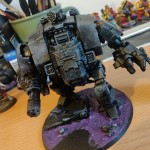The icy weather outside reminded me that I hadn't posted this yet. Last month, I attempted to add realistic looking ice to the bottom of this base. Read on to learn from my trial & error :)
I had a blast working on this model from Reaper which I picked up a year ago to represent my wife's D&D character. I wanted to have this all finished up in time to surprise her on Christmas but then I got way into working on the base and trying to get the textures as realistic as possible. The rock base was something I got in a lemonade raffle years ago and I couldn't tell you what material it is made out of (plaster maybe; it left a chalky gray residue to the touch), but it has a nice heft to it. I pinned the metal mini to the top and even had to pin the rock to the 50mm base as it refused to adhere with any type of glue in my possession.
After some lite citadel Ice Blue drybrushing and Baharroth Blue edge paint along the rim of the 50mm, the entire base received a healthy dose of Nuln Oil Gloss wash. This step transformed the dusty dry rock into a shimmering frozen bedrock. I then added patches of snow, using a tried & true method, followed by white grass tufts on the flatter ledges around the rock. It was starting to come together, but I really wanted the ice at the base of the base (ha) to look like real ice. I had some Triple Thick Gloss Glaze on hand so I first tested it out on a spare 20mm base, pictured above. I wasn't all that careful applying the stuff to the test base, but I did give it a full 2 days to dry before deciding to give it a go.
I was aiming to achieve a nice thick layer of ice, several millimeters at least to encompass a bit of the rock, but had to rig up a temporary border to prevent the glaze from oozing over the edge of the 50mm base.
I can't remember what this stuff is called but it's not playdoh. It's much denser and firm, but I still made sure to flatten the sidewall with a roller to avoid any fingerprints; I wanted the outside edge of the ice to be smooth and flush with the top edge of the 50mm base. Carefully, I squeezed the glaze from the bottle onto the base, then used an old brush to work the glaze around the rock face (trying not to overwork the material as cautioned by the bottle).
Then, I gave it two full days to dry.
I was hoping the putty mold would peel off from the dried glaze without issue, to reveal a smooth, even layer of shiny ice that still allowed some of the painted blue highlights to shine thru...
Of course that didn't happen, haha. Some of the putty stuck to the glaze as it cured, and not only that, there were pockets of air introduced from the glaze not settling into all the grooves and spaces around the rock. Cue sad trombone.
Attempting to salvage the experiment, I carefully trimmed the putty from the edge; but the glaze dried white instead of clear around some of the pockets of air... maybe I could pretend there's a layer of permafrost below the ice...
Nope. I had to gut it and start over. Removing the rest of the glaze without damaging the base (or cutting myself) was a little challenging. Licking my wounds, at least I had a few more lessons learned from this experiment.
After some minor paint touch-up on the rock and edge of the base, I decided to play it safer on attempt #2, and simply applied the gloss glaze using a brush (kinda like the bottle recommends, but nevermind that):
The shiny layer still adds something to the atmosphere of the base, so I'm pleased with it. More importantly, my wife really likes it 💗
UPDATE: alternative realistic ice/water product from Woodland Scenics reviewed here.





































.png)









.JPG)












































































































































No comments:
Post a Comment